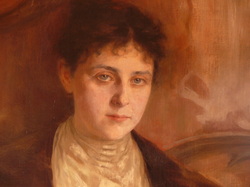
This week saw the publication of ‘Egyptology and Photography: Two Founding Fathers’ in Ancient Egypt magazine. This project had its roots in a visit I paid to the house of a family friend many years ago, when I caught sight of a painting hanging on their wall. The portrait was by Reinhold Lepsius, one of the children of the Egyptologist Karl Richard Lepsius.
I was – and remain – absolutely captivated by this portrait and was keen to learn more about the artist and his family. I had heard of Karl Lepsius and knew a little about his pioneering work in the field of Egyptology, but as I began reading more about his personal life and achievements, my attention was caught by references to his attempts to use photography in his seminal expedition to Egypt in 1842. Accounts of photography in the Middle East seemed to have overlooked this plan by Lepsius, largely because he returned without any photographs: the expedition’s findings were published in a monumental twelve volume work, Denkmaler aus Aegypten und Aethiopien (1849-58) which included nearly 900 plates, based on drawings and paintings undertaken on location. It is easy to see why Talbot wanted to support Lepsius, given his interest in Biblical archaeology, ancient languages and eastern antiquities. Research for the article brought back memories of the passion I used to have for the same topics – how I had travelled to Durham to visit the Gulbenkian Museum, to Oxford to gaze upon the Weld-Blundell prism, to Dublin to see the magnificent Book of Kells…and I felt humbled in a way, that my entire experience had come solely from museums and libraries. The hardships and dangers endured by Lepsius and other contemporary travellers makes for hair-raising reading at times.
I was – and remain – absolutely captivated by this portrait and was keen to learn more about the artist and his family. I had heard of Karl Lepsius and knew a little about his pioneering work in the field of Egyptology, but as I began reading more about his personal life and achievements, my attention was caught by references to his attempts to use photography in his seminal expedition to Egypt in 1842. Accounts of photography in the Middle East seemed to have overlooked this plan by Lepsius, largely because he returned without any photographs: the expedition’s findings were published in a monumental twelve volume work, Denkmaler aus Aegypten und Aethiopien (1849-58) which included nearly 900 plates, based on drawings and paintings undertaken on location. It is easy to see why Talbot wanted to support Lepsius, given his interest in Biblical archaeology, ancient languages and eastern antiquities. Research for the article brought back memories of the passion I used to have for the same topics – how I had travelled to Durham to visit the Gulbenkian Museum, to Oxford to gaze upon the Weld-Blundell prism, to Dublin to see the magnificent Book of Kells…and I felt humbled in a way, that my entire experience had come solely from museums and libraries. The hardships and dangers endured by Lepsius and other contemporary travellers makes for hair-raising reading at times.